Livingston Island
| Livingston Island | |
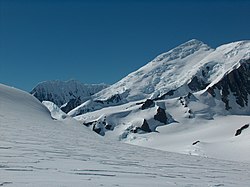 Tangra Mountains | |
|---|---|
| Location | |
| Location: | 62°36’0"S, 60°30’0"W |
| Area: | 376 square miles |
| Highest point: | Mount Friesland, 5,577 feet |
| Data | |
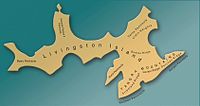
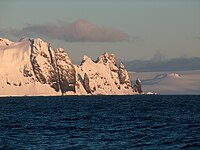
Livingston Island is an island of 376 square miles amongst the South Shetland Islands, part of the British Antarctic Territory, lying between Greenwich Island and Snow Island. This island was known to sealers as early as 1819, and the name Livingston, although of unknown derivation, has been well established in international usage since the 1820s.
Its historical Russian name was Smolensk, a name given by Bellingshausen on his circumnavigation of Antarctica.
Geography

Livingston is one of the South Shetland Islands. It lies in the Southern Ocean 68 miles northwest of Cape Roquemaurel (Graham Land), 620 miles due south of the Falkland Islands.
Livingston is separated from the neighbouring Greenwich Island to the east and Snow Island to the west-southwest respectively by McFarlane Strait and by Morton Strait. Deception Island, located barely eleven miles south-west of Livingston's Barnard Point in the Bransfield Strait, is a volcano whose caldera forms the sheltered harbour of Port Foster entered by a single narrow passage known as Neptune's Bellows.
The island extends 45 miles from Start Point in the west to Renier Point in the east, its width varying from 3 miles at the neck between South Bay and Hero Bay to 21 miles between Botev Point to the south and Williams Point to the north, with surface area of 308 square miles.[1]
There are many islets and rocks in the surrounding waters, particularly off the north coast. More sizable among the adjacent smaller islands are Rugged Island off Byers Peninsula (which also contain a small freshwater lake named Basalt Lake), Half Moon Island in Moon Bay, Desolation Island in Hero Bay and Zed Islands to the north.
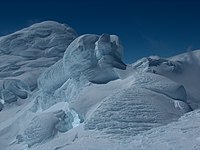

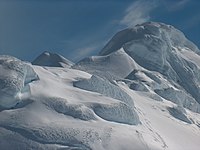
Ice cliffs, often withdrawing during recent decades to uncover new coves, beaches and points, form most of the coastline. Except for isolated patches, the land surface is covered by an ice cap, highly crevassed in certain segments, with ice domes and plateaus in the central and western areas, and a number of valley glaciers formed by the more mountainous relief of eastern Livingston. Typical of the island's glaciology are the conspicuous ash layers originating from volcanic activity on the neighbouring Deception Island.
Apart from the extensive Byers Peninsula (24 square miles) forming the west extremity of Livingston, the ice-free part of the island includes certain coastal areas at Cape Shirreff, Siddons Point, Hannah Point, Williams Point, Hurd Peninsula and Rozhen Peninsula, as well as slopes in the mountain ranges, and ridges and heights in eastern Livingston that are too precipitous to keep snow.
The principal mountain formations include:
- The Tangra Mountains (19 miles long, with Mount Friesland rising to 5,577 feet);
- Bowles Ridge (4 miles, elevation 2,697 feet)
- Vidin Heights (5 miles, 1,982 feet)
- Burdick Ridge (2,536 feet)
- Melnik Ridge (2,283 feet)
- Pliska Ridge (2,188 feet)
- Oryahovo Heights (4 miles, 1,115 feet), and
- Dospey Heights (4 miles, 869 feet).
The coastline of the island is irregular, with the more significant indentations:
- Bays:
- Peninsulas:
- Hurd Peninsula (extension 6.2 miles),
- Rozhen Peninsula (5.6 miles)
- Burgas Peninsula (6.5 miles)
- Varna (7.5 miles)
- Ioannes Paulus II Peninsula (8.0 miles) and
- Byers Peninsula (9.3 miles).
The local variety of the Antarctic Peninsula weather is particularly changeable, windy, humid and sunless. Says Australian mountaineer Damien Gildea: 'Livingston got just about the worst weather in the world'. Whiteouts are common, and blizzards can occur at any time of the year. Temperatures are rather constant, rarely exceeding 3°C in summer or falling below −11°C in winter, with wind chill of 5°C to 10°C lower.
History of exploration
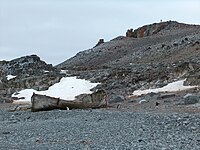

Livingston island was the first discovered island of the Antarctic, in the nineteenth century. Captain William Smith in the British merchant brig Williams, while sailing to Valparaiso during 1819 deviated from his route south of Cape Horn, and on 19 February sighted the northeast extremity of Livingston, now named Williams Point.
A few months later Smith revisited the South Shetlands to land on King George Island on 16 October 1819 and claim possession for Britain. In September 1819 the 74-gun Spanish ship San Telmo, commanded by Captain Rosendo Porlier, had been damaged by severe weather in the Drake Passage and sunk off the north coast of Livingston with the loss of all hands; more than 600 men, who had the dubious distinction of being the first recorded deaths in Antarctica. Parts of her wreckage were found subsequently by sealers on Half Moon Beach.
During December 1819 William Smith returned with his ship to the South Shetlands. This time he was chartered by Captain William Shirreff, British commanding officer in the Pacific stationed in Chile, and accompanied by Lieutenant Edward Bransfield who was tasked to survey and map the new lands. On 30 January 1820 they sighted the mountains of the Antarctic Peninsula, unaware that three days earlier the continent had already been discovered by the Russian Antarctic expedition of Fabian Gottlieb Thaddeus von Bellingshausen and Mikhail Petrovich Lazarev.
The Russians had circumnavigated Antarctica in 1820 and arrived in the South Shetlands region during January 1821 to find over 50 American and English sealing vessels and 1000 men taking hundreds of thousands of fur seal skins. While sailing between Deception Island and Livingston (named 'Smolensk' by the Russians) Bellingshausen met the American Captain Nathaniel Palmer, an American pioneer of Antarctic exploration, who is alleged to have sighted the mainland himself during the previous November.

Remains of huts and sealer artefacts are still found on Livingston, which possesses the greatest concentration of historical sites in Antarctica. The names of many geographical features on the island also refer to its early history. Among the commemorated are ship captains such as the Americans Christopher Burdick, Charles Barnard, Robert Johnson, Donald MacKay, Robert Inott, David Leslie, Benjamin Brunow, Robert Macy, Prince Moores and William Napier, the Britons William Shirreff, M'Kean, John Walker, Ralph Bond, Christopher MacGregor, T. Binn and William Bowles, the Australian Richard Siddons, people like the New York shipowner James Byers, the American whaling merchants William and Francis Rotch, British Admiralty hydrographer Thomas Hurd, and John Miers, publisher of the first chart of the South Shetland Islands based on the work of William Smith, or sealing vessels like Huron, Williams, Samuel, Gleaner, Huntress, Charity, Hannah, Henry, John, Hero and others.
Some of the place names given by the nineteenth century sealers are descriptive, such as Devils Point, Hell Gates and Neck or Nothing Passage, hazardous places where ships and people were lost; Inept Cove, Needle Peak, or the Robbery Beaches where American sealers claimed to have been robbed of their sealskins by British sealers. However, names like Livingston, Mount Friesland and Renier Point also became established during the first few seasons after the discovery of the islands, yet their particular origins remain unknown.
Scientific bases

The first modern, 'post-sealer' habitation facility on Livingston Island was the British base camp Station P that operated in Hannah Point area during the 1957/58 summer season. The permanent scientific bases are:
- Juan Carlos I (Spain)
- St. Kliment Ohridski (Bulgaria) were established in 1988 at South Bay.
Other base facilities are:
- Shirreff Base (or Guillermo Mann, Chile and the USA) on Cape Shirreff since 1991
- Cámara (summer only, Argentina) on nearby Half Moon Island since 1953.
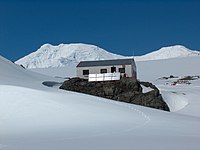
Occasional field camps support research in remote areas of the island. Camp Byers (Spain) operates regularly near Nikopol Point on Byers Peninsula, the seasonal Camp Livingston (Argentina) is also situated on Byers Peninsula, and the Camp Academia site situated at elevation 1,775 feet in upper Huron Glacier, Wörner Gap area served as a base camp of the Tangra 2004/05 topographic survey. Camp Academia is accessible by routes from St Kliment Ohridski Base and Juan Carlos I respectively, and offers convenient overland access to Tangra Mountains to the south; Bowles Ridge, Vidin Heights, Kaliakra Glacier and Saedinenie Snowfield areas to the north; Huron Glacier to the east; and Perunika Glacier and Huntress Glacier to the west. Camp Academia was named for the Bulgarian Academy of Sciences in appreciation of Academy's contribution to the Antarctic exploration, and has been designated as the summer post office Tangra 1091 of the Bulgarian Posts since 2004. A US seasonal field camp on Byers Peninsula was wrecked by storm and emergency evacuated in February 2009.[2]
Protected areas
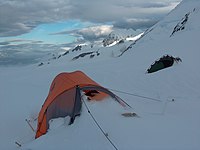
In order to protect Antarctica, the Antarctic Treaty system enforces a strict general regime regulating human presence and activities on the continent, and designates certain protected territories where access is allowed only for scientific purposes, and with special permission.
There have been two such nature reserves on Livingston Island since 1966, comprising respectively the extensive Byers Peninsula, and the small peninsula of Cape Shirreff together with San Telmo Island and adjacent waters.
Subject of protection are the island’s variety of abundant flora and fauna including colonies of seals and penguins that are the subject of scientific study and monitoring, as well as numerous historical monuments dating from the nineteenth century. Also the island has fossils demonstrating the link there once was between Antarctica and other southern continents.
Tourism
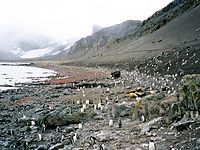
Antarctic shipborne tourism was initiated in 1958 in the South Shetland Islands. Since then the number of tourists visiting Antarctica has grown to tens of thousands annually, of whom over 95% tour the South Shetlands and nearby Graham Land. Hannah Point on the south coast of Livingston and Half Moon Island off the east coast, as well as the nearby Deception Island and the Aitcho Islands near Greenwich Island are among the most popular destinations frequented by cruise ships, offering walks amidst spectacular scenery and amazing wildlife.
Bulgarians
The Bulgarian Academy of Sciences has had a presence on Livingstone Island for many years; that country's particular effort in Antarctic scientific research within the British Antarctic Territory. Bulgaria operates the St Kliment Ohridski Base and established Camp Academia as an outpost from it, named for the Bulgarian Academy of Sciences. Camp Academia is a summer post office of the Bulgarian postal service.
Several squares and streets in Bulgarian towns and cities are named after Livingston Island, such as Livingston Island Square in Samuil and Kula, and Livingston Island Street in Gotse Delchev, Yambol, Petrich, Sofia, Lovech and Vidin.
Outside links
| ("Wikimedia Commons" has material about Livingston Island) |
- 70south - more information on the South Shetland Islands including Livingston Island
- Expedition Tangra 2004/05
- Spanish base Juan Carlos I
- Expedition Omega Livingston 2003
- Protected area Byers Peninsula. Management Plan and Map.
- Protected area Cape Shirreff. Management Plan and Map.
References
- ↑ L.L. Ivanov. Antarctica: Livingston Island and Greenwich, Robert, Snow and Smith Islands. Scale 1:120000 topographic map. Troyan: Manfred Wörner Foundation, 2009. ISBN 978-954-92032-6-4 (Second edition 2010, ISBN 978-954-92032-9-5)
- ↑ Antarctic Sun, March 6, 2009
Books
- S. Soccol, D. Gildea and J. Bath. Livingston Island, Antarctica. Scale 1:100000 satellite map. The Omega Foundation, USA, 2004.
- L.L. Ivanov et al. (from English Strait to Morton Strait, with illustrations and ice-cover distribution). Scale 1:100000 topographic map. Sofia: Antarctic Place-names Commission of Bulgaria, 2005.
- Text authorized for publication in Wikipedia by the Antarctic Place-names Commission of Bulgaria.
| The South Shetland Islands, British Antarctic Territory |
|---|
|
Bridgeman • Clarence • Cornwallis • Craggy • Deception • Elephant • Gibbs • Greenwich • Half Moon • Heywood • King George • Livingston • Low • Nelson • Penguin • Robert • Rowett • Rugged • Smith • Snow |

